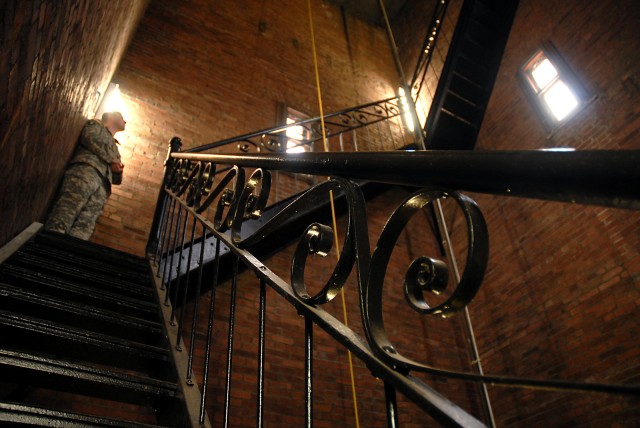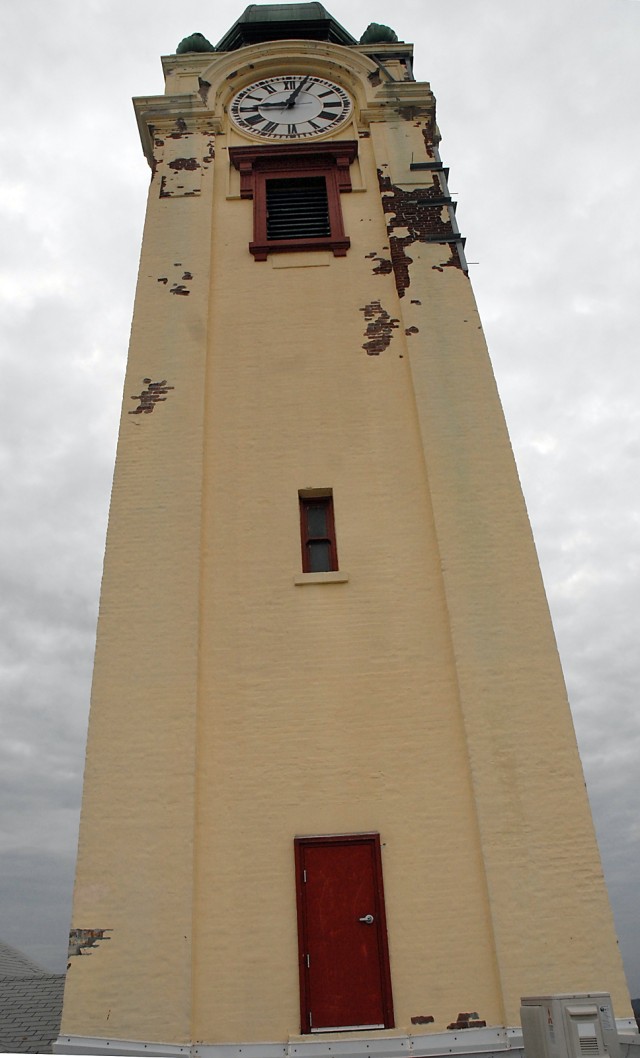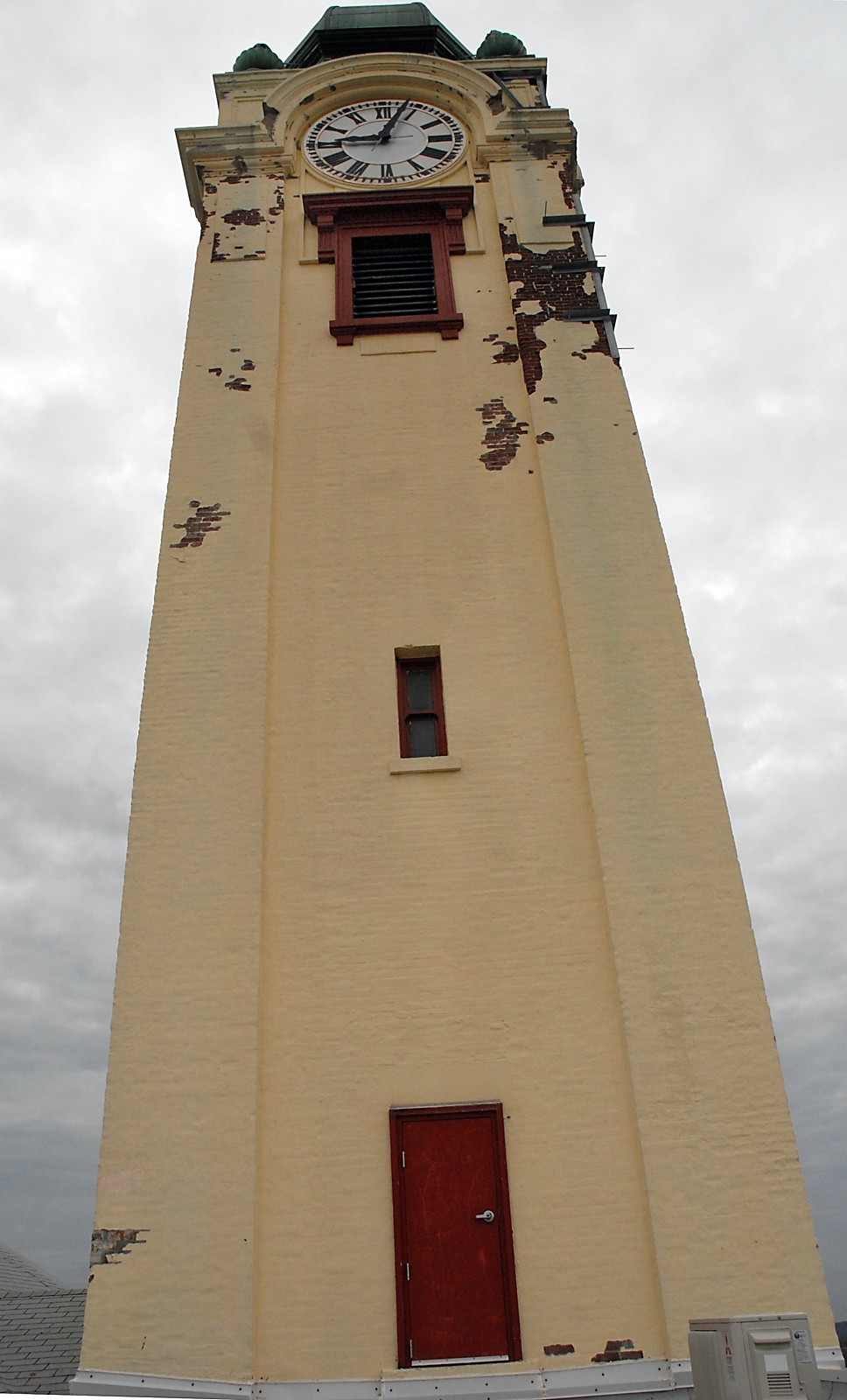FORT LEAVENWORTH, Kan. (April 1, 2010) - Fort Leavenworth's most visible landmark is about to get a major renovation.
This summer, federal stimulus funds are allowing for a $1.69 million renovation of the clock tower over above the Combined Arms Center headquarters at 415 Sherman Ave.
Bob Beardsley, cultural resources manager; Lee Cox, branch chief of Contract Administration, DOL/ DPWAca,!E+Engineering Division; and David Murdock, project manager for engineering; are all working on the project from the Directorate of Logistics and Public Works.
"It's basically doing a whole remodel," Murdock said. "In the end it will look the same as it does now, but they're redoing all the bricks again."
Without intervention, Fort Leavenworth's historic clock tower could collapse, Murdock said.
"It's a symbol of Fort Leavenworth and the (Command and General Staff College), for the Army," Murdock said. "It's a landmark that's been in place for over 100 years."
Cox said the clock tower does have a working clock. At one time it was mechanical, but has since been converted to electrical. Two counterweights for the clock once hung inside the tower.
DOL/DPW officials said the clock tower will look very different for about a year after the renovation.
Plans are to reconstruct the clock tower by replacing the outer layer of bricks, replacing and fixing the limestone pieces and replacing the copper dome. To allow the new layer of bricks to completely dry, the outer layer of bricks will remain unpainted and exposed for one year.
Beardsley said the paint is one reason the clock tower is beginning to crumble. However, it's not the first issue that has caused problems for the structure.
The clock tower's construction was completed in 1907, along with Grant Hall. Both the clock tower and Grant Hall were built to connect two armories, Sherman and Sheridan halls, originally built in the 1850s. The clock tower bricks were laid using cement, not mortar. Beardsley said by World War II, there was already evidence of "spalling," or bricks beginning to chip away in pieces because they shrank and swelled more than the cement. Because of the unsightly chipping at that time, Beardsley said someone decided to start painting the clock tower. It was painted several times until about 20 years ago, when plaster paint was applied.
The plaster, intended to be a solution, actually caused more chipping, Beardsley said. It trapped a layer of moisture underneath, which froze. Over the years, the plaster limited the bricks' ability to breathe and sped up the decay.
"The dome is leaking and has been for some time," Beardsley said. "That's what's letting water into the stonework."
In 2008, after a large piece of the tower wall fell, metal stints were put in along the northwest corner to stabilize the structure. Fort Leavenworth officials began the process of seeking funding and letting out bids for a contract to fix the clock tower and, in January of this year, awarded the general contractor bid to Hydro-Tech, Inc.
Murdock said by mid-April, Fort Leavenworth residents should see scaffolding go up around the tower. Contractors will carefully remove the decayed bricks and replace them in sections to keep the tower from collapsing in the process. The bricks are being specially ordered to be historically accurate.
The green copper dome will come down. Murdock said plans are to construct a new dome on site, using an aging method to turn the new copper green, and raise it into place.
Staff Sgt. Jon Brisbane, of the CAC headquarters staff, is responsible for fixing the clock itself when a work order is requested. The clock works, but has been disconnected from the bell as a precaution against more damage being caused by the bell's reverberation.
DOL/DPW officials said with the tower's reconstruction, they should be able to reconnect the bell.
Brisbane said scaffolding would be around the tower itself, not the buildings below. Workers will only be able to access the scaffolding from inside the building.
The newest renovation should keep the clock tower standing for another 100 years, Murdock said, with perhaps some mortar replacement in about 40 years.




Social Sharing